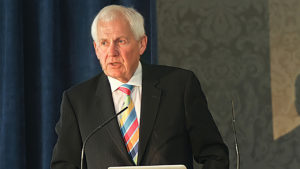You have built your brand as The CEO Expert largely on driving change and innovation. Why is innovation so important?
Markets have been changing rapidly in recent years and Brexit has only increased the uncertainty. Personally, I see this as a very good thing. Never before have things moved so quickly. Technology is changing constantly and consumers do not have the loyalty they once did. If you embrace this new world then anything is possible.
Ultimately it’s your choice to decide whether the glass is half empty or half full, but what I generally find is that the UK tends to treat this uncertainty with fear, which really holds us back. When I’m giving a talk in the UK and I ask how many of the business leaders in that room have an app, for example, I’m lucky to get more than a couple raising their hands, whereas when I ask that question in the third world more than half the room raises their hand! No wonder we’re getting left behind!
I think this is the most exciting time ever to be in business. In Lahore, for example, they had over 60,000 cases of Denge fever a year but via an app that was developed locally, they’ve now reduced that to just a handful. In Sweden, they’ve just developed an app that’s proved to be as successful as a form of contraception like the pill. The possibilities are limitless.
What are the challenges of achieving this kind of innovation?
The big challenge is working out where it should come from. Most of this stuff is either free or very cheap and you give your IT and sales departments budgets so it probably won’t come from them. And even if it did, how would they in turn drive innovation in other departments such as HR, marketing or finance?
The bottom line is that it isn’t enough to have one function responsible for innovation. It has to come from everywhere. It has to be woven into the very fabric of the company. This is not an evolution but rather a revolution, and some businesses may simply prove too big and immobile to adapt. These, I’m afraid, are the companies that, as untouchable as they may seem today, may not be with us in twenty years from now.
So what are the ways in which you can create a culture that consistently drives this kind of innovation?
Realise what’s at stake
Companies must, first of all, realise how significant this is. Put simply, those that fail to make this change will disappear. That may seem a bold statement but who would ever have guessed that Nokia and Kodak would ever be left behind in the way that they have?
Accept failure
Innovation by its very nature will often lead to nothing. You can either treat that as a huge failure and something to be avoided, or actively encourage it as part of the innovation culture.
Realise that it applies to all functions/departments
No department should be exempt from this change, even finance. A few years ago one of the companies I was involved in the decision to flip their P+L upside down. After all, profit was the most important thing. Sales were several lines down as it’s all too easy to become a busy fool. Your average accountant would find this horrifying but if there is a better way of doing something then that change needs to happen. No exceptions.
Hire young people
For the first time in the history, there are people with no experience who have more knowledge in key strategic areas than their leadership team. If Snapchat, for example, is a key future route to market for your business, who in your existing leadership team is going to identify that? You have to drive millennials into the team at a faster rate and find a way to get them on the top table. You cannot flourish without their input.
Culture of transparency
In order to drive innovation people need to care about the business they’re in, and it’s very difficult for employees to do that when they feel shut out by the leadership team. One of the companies I work with have overcome this brilliantly by ensuring that every single employee receives the full set of company financials, and each quarter two employees are invited to the board meeting. Anyone can volunteer and these people then share their experience with their coworkers, fostering an enormous degree of trust.
This culture of openness breeds a level of passion in their business that I have rarely seen elsewhere, and consequently, people in all departments are coming up with ideas for driving the business forward.
Encourage leadership and ownership at all levels
In order to have innovation in all areas and levels of the business, you need to ensure your team is packed with people who want to take ownership, think for themselves and drive change. I remember being told that in the SAS there are small teams with a mixture of skills, and while there is always someone in charge, in practice anyone on that team has to be capable of leading because you never know what will happen. The same goes for business. The more natural leaders you have on your team the more innovative and resilient you will become.
Spend more time on recruitment
Ultimately it all comes down to people, and while you can encourage your staff to be creative and innovative, 90% of it is determined by the hiring decision you make in the first place. And yet, for some reason, this is an area most leaders give little thought to.
CV’s tell you nothing and it’s been shown that if you recruit using the conventional two interview process, you will make the wrong decision 60% of that time. That’s why I encourage companies to give up on this traditional approach and instead create a practical scenario that actually shows the candidate in action. They should be auditioning rather than interviewing.
Get your HR under control
HR have a lot to answer for. Their job should be to improve the company by getting more out of its people, and yet they often act more like lawyers. HR managers tend to be too risk-averse and only seem happy when they’re making you and everyone else tick boxes. This can be hugely damaging. If you have a bad apple it cannot take six months for you to get them out, and it should be HR’s job to help you speed that up, not slow it down.
Lead by example
Finally, a business leader needs to lead by example and get to grips with the technology that will shape their industry. By this, I do not mean that they have to give up their day job and become an engineer or computer programmer, but they need to understand the strategic implications of technology. I don’t know how a microwave works, but I know what it does!
For example, when I had 3000 employees I would have loved a tool like Periscope. I could have set up a video call every Friday at 10am and spoken to everyone live (for free!), whilst also allowing them to speak back to me. Yet how many leaders are doing that?
Great leadership has always been about getting up in your helicopter and looking down on the business to not only see what’s truly working and what isn’t. With technology now advancing at the pace that it is, this helicopter view is more important than ever so that you can also see what great change is next on the horizon. Leaders must be able to detach themselves from their business for at least 20% of the time and focus on the future. It will be with them before they know it!




